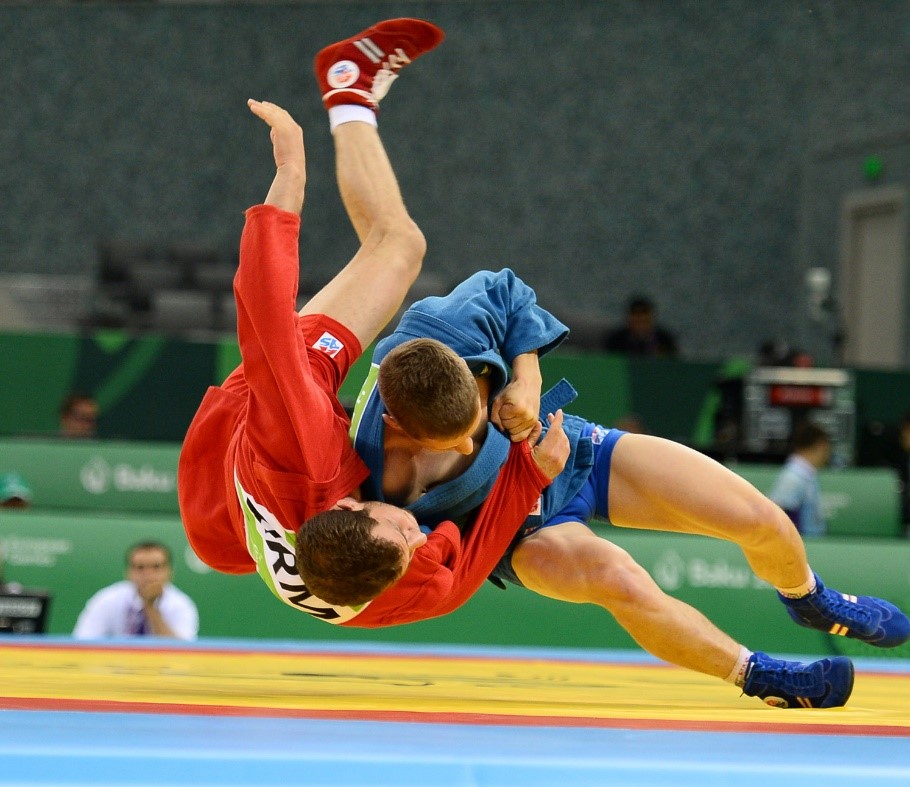
© Vugar Amrullayev, 2015 |
|
|
|
|
| General Information |
Sambo is an acronym for samooborona bez oruzhiya, meaning ‘self-defense without weapons’ in Russian (Tausk 2001).
Due to the fact sambo had to serve as a neutral and national fighting art that would unite the nation it borrows techniques from many traditional martial arts.
There are three types of sambo (Tausk 2001): military sambo, self-defense sambo and sports sambo. Each of them has its own characteristics.
Military sambo is designed for combat situations. Self-defense sambo is taught to city police and civilians. It consists mainly of techniques to handle certain types of physical attacks. The rules of sport sambo were codified during the 1930s. Sport sambo is popular all over the world and its inclusion in the Olympic Games has been discussed. As it also took many techniques from judo it is similar in many aspects.
The uniform used in sambo is similar to a judogi but the vest is tighter, has belt loops and reinforced shoulders and the pants are short, similar to wrestling shorts. Usually shoes are worn as well. Outfits are either red or blue with matching shoes. The uniform is called “kurtka”, after the native dress. Jacques and Anderson point the tighter fit of the the kurtka complements the low to the ground fighting style, but allows for the secure grips to perform the judo-like throws and chokes (Jacques and Anderson 2016: 56). |
| History/Development |
Sambo was developed by Anatolij A. Kharlampiev, Viktor A. Spiridonov, and Vasilij S. Oshchepkov in the 1930s in the former Soviet Union (Tausk 2001). There is some speculation about which of the three individuals should be seen as the actual founder.The creation of sambo was an attempt to create a true “Soviet” fighting art in line with the government’s intention to create a united culture for the USSR.Anatolij A. Kharlampiev spent years traveling around the Soviet Union analyzing and observing the native fighting systems (Tausk 2001). |
Transmission
(Policies/institutions) |
Sambo is still the self-defense system taught to select army units as well as to intelligence services and city police in Russia. Sport sambo is popular worldwide these days and taught in many schools. |
| Relevant Organisations |
- International Sambo Federation (FIAS)
https://sambo.sport/en/
- European Sambo Federation |
| Additional Materials |
- Jacques, Brett, and Scott Anderson. 1999. “The Development of Sambo in Europe and America.” Journal of Asian Martial Arts 8, no. 2: 20–41.
- Lukashev, Michail. 2000. “Creation of Sambo.”
http://cclib.nsu.ru/projects/satbi/satbi-e/statyi/sambo.html.
- Eigminas, P. 1992. Sambo: Pervye Shagi (Sambo: The First Steps). Moscow: Fizkultura i Sport.
- Retjuskikh, Alexander I., and S. I. Zajashnikov. 1992. Russkij Still’
- Rukopashnogo Boja—Stil’ Kadochnikova (Russian Style of Hand-to-hand Combat—Kadochnikov Style). Novosibirsk, Russia: Vest’.
- The Undefeated (movie)
- Moscow Does Not Believe in Tears (movie)
- The Individual Swimmer (movie) |
| References |
- Tausk, G.P. (2001), “Sambo” In Green, T. and Svinth, J. (eds.) Martial Arts of the World: An Encyclopedia of History and Innovation. Santa Barbara, CA: ABC-CLIO.
- Jacques, B. and Anderson, S. (2016). “The Development of Sambo in Europe and America”. In DeMarco, M.A. (ed.). Sambo and Systema: Russia’s Prominent Martial Arts, Santa Fe: Via Media Publishing. |
*see also: kokh, chidaoba | |

